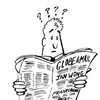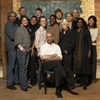On Wednesday, September 13, the calm of a rainy early afternoon at Montreal’s Dawson College was broken by gunfire. Kimveer Gill entered the campus carrying a semi-automatic Beretta and began shooting like a child at a midway game. He fired 60 shots, wounding 20 people and killing one before turning the gun on himself.
Three days later, another kind of shot was fired, this time by veteran reporter Jan Wong of The Globe and Mail. Wong’s long, compelling investigation of what happened at Dawson that day, as seen through the eyes of one faculty member, entitled “‘Get Under the Desk’,” was published in the National News section of the Saturday, September 16 edition of the Globe. In the article, she speculated that Quebec’s pure laine language policy might partly be to blame for the shootings because it had fostered isolation and racism towards English-speaking Quebecers. Irate readers, including Prime Minister Stephen Harper and Quebec Premier Jean Charest, sent in letters of protest. Numerous journalists also weighed in — mostly against Wong and her damning cultural assertion — on the Canadian Association of Journalists listserv.
But, buried underneath the rubble of whether or not Wong’s comments constituted a form of discrimination against French-speaking Quebecers lay an important journalistic question: Should a reporter be allowed to editorialize within a news feature?
Anthony Westell struggled with this exact issue while riding on John Diefenbaker’s train when covering the 1965 federal election campaign. At the time, he was the Globe‘s Ottawa bureau chief. “I had noted during the campaign Diefenbaker saying things that I knew to be incorrect,” he says. While other journalists reported Diefenbaker’s argument plainly and then got the other side, Westell tried a different approach. Instead, he corrected Diefenbaker’s errors by constantly undercutting his argument, dotting contradictory facts throughout the article in parentheses. “I had certain anxieties about what I was doing,” he says, “since I didn’t know what my editor would think, or whether my article could be published.”
Westell reported to then-editor-in-chief Dic Doyle, who praised the piece and only cut for length. While that particular story ran in the commentary section, Westell says he put his own brand of editorial analysis into his reporting from then on.
Wong’s article began with the story of Pina Salvaggio, a mother who teaches at Dawson, searching for her son, a student. So far, so good — this part of the story was generally well received. However, about 500 words into her 3,000-word-plus feature, she linked the Gill rampage to previous Montreal shooting sprees, one by Marc Lepine at Ecole Polytechnique in 1989, and another by Valery Fabrikant at Concordia University in 1992. Wong then wondered if all three shootings weren’t the result of a language policy that discriminates against English Quebecers. She wrote: “What many outsiders don’t realize is how alienating the decades-long linguistic struggle has been in the once-cosmopolitan city. It hasn’t just taken a toll on long-time anglophones, it’s affected immigrants, too. To be sure, the shootings in all three cases were carried out by mentally disturbed individuals. But what is also true is that in all three cases, the perpetrator was not pure laine, the argot for a ‘pure’ francophone. Elsewhere, to talk of racial ‘purity’ is repugnant. Not in Quebec.”
This paragraph provoked both the Prime Minister’s Office and the Quebec Premier’s office into action, and the leaders wrote letters to the editor. An incensed Harper wrote, “[Wong’s] argument is patently absurd and without foundation. It is not only grossly irresponsible on her part, it is also completely prejudiced to lay blame on Quebec society in this manner.”
Globe editor-in-chief Edward Greenspon responded in his column the following Saturday, September 23. He defended the first part of Wong’s story and noted that the reaction to it was disproportionate, but concluded by saying, “[The offending] paragraphs were clearly opinion and not reporting and should have been removed from that story. To the extent they may have been used, they should have been put into a separate piece clearly marked opinion.”
But Westell often editorialized in his news reporting throughout his long career, and other high profile journalists such as Peter C. Newman combined reporting and opinion, with his stories often appearing on the cover of The Toronto Star. Westell believes that Wong’s article is appropriate in a newspaper. “This was not a straight news piece,” he says. “She was offering analysis and reasoning for why something happened the way it did, and is perfectly entitled to her own opinion.”
Readers are certainly entitled to disagree with the writer’s opinion. Jeffrey Dvorkin, executive director of the Committee of Concerned Journalists and ex-ombudsman for National Public Radio, says Wong’s opinion was unsupported and didn’t illuminate the story. Rather, it served to aggravate relations between French and English Canadians. “Expressing a personal opinion is not the same as news analysis,” he says. “There is a role for news analysis, but it has to be based on factual reporting. In the end, her opinion was based on an expression of her personal vanity and not an expression of knowledge.”
Barbara Kay agrees. The National Post columnist knows what it’s like to be in the crosshairs of Quebec’s public feedback. She, too, once raised Charest’s ire after suggesting that Quebec could become a breeding ground for Islamic terrorism in her article, “The Rise of Quebecistan,” last August. However, she says Wong often crosses the line between opinion and news for the sake of controversy. She blames negligent editing for the quarrel around Wong’s article. “They know what she is,” Kay says, “and she has said many stupid things in the past.”
Andrew McIntosh, a former colleague of Wong’s who now works at The Sacramento Bee, disagrees. “Her dual role as a columnist and feature writer puts her in a confusing spot to begin with. Is she a columnist, or feature writer, or both?” he asks. “Line editors of marquee writers and columnists are not properly instructed on how to deal with situations where a writer does both jobs, so the copy doesn’t get edited specific to both roles.”
Bill Dunphy, who works the poverty beat for The Hamilton Spectator, thinks the solution is better labeling. “Whenever I read a Jan Wong story, I know exactly what I’m getting. I think probably not all newspaper readers pay that much attention. So it’s up to us to label things for them.”
The New York Times created a committee for specifically that purpose. The News/Opinion Divide Committee worked for nine months to create a system to distinguish between columns, reviews and straight-news pieces using labels and layout. The changes went into effect September 27.
But even if the Globe story lacked sufficient labeling, Dunphy still defends the reporter. “When you send someone like Jan Wong, you’re really looking to hear her voice. She’s largely fearless — you get opinions that other people may have that they don’t have the guts to say out loud, and that I find useful to have in a newspaper. The Globe backed away from that. “
About the author
Aaron Broverman was the Associate Editor for the Summer 2007 issue of the Ryerson Review of Journalism.

